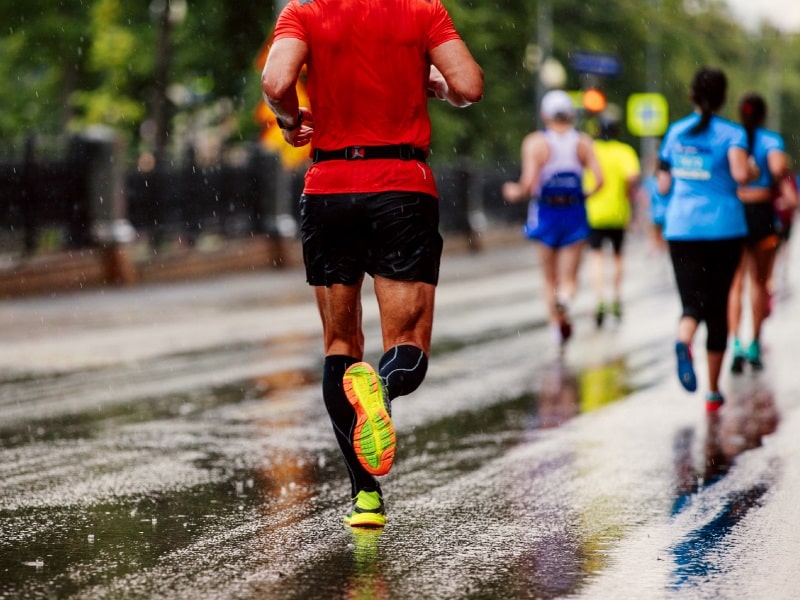How to choose running shoes?

Holiday is a time when many of us begin our adventure with physical activity. Beautiful weather, sunshine and long days make us more willing to leave the house to move around a bit. For a few years now, the fashion for running has been constantly reigning among sports. Unfortunately, not everyone is aware of the importance of the right running shoes for the proper performance of this activity.
In case of running, the choice of footwear is of great importance. Before you go to the store, first determine the type of your foot and think about what kind of ground you’re running on. Remember that distance is also important – the longer the route, the more durable the shoes should be.
FIRST CHECK YOUR FOOT TYPE
The construction of the foot forces the selection of a specific shoe model.
From among the different types of feet, one can distinguish oneself:
- neutral foot – that is, one that has a normal conquest. It is characterized by the fact that while running it makes the correct movement. The body weight is distributed evenly over the entire foot – starting from the heel and ending with the moment of the toe.
- an excessively pronounced foot – meaning an overly pronounced internal ankle deflection with respect to the tibia. This is usually associated with a flat foot and a low conformation.
- over-supervising foot – this type means that the ankle is too far outwards from the tibia. Usually this goes hand in hand with a high conquer. Runners who have this type of foot are exposed to ankle twisting, hip and tibial band overload and have less resistance to shocks.
How do you check your foot type yourself? If not in a shoe shop, it is best to wet the bottom of your foot and reflect it on a piece of paper. If the reflection does not show an arch on the inside of the foot, our type of foot is overly laundered (flatfoot).
However, if the indentation is relatively small (medium size) – our type of foot is neutral. The last type is excessively supine – in its case the indentation is the largest, and only the external part of the foot is reflected on the card.

THINK ABOUT WHAT YOU WILL RUN AFTER
Apart from the shape of the foot, the ground on which we will run is also extremely important. Shoes for hard surfaces should be very flexible, perfectly shock absorbing and lightweight. Such boots can have a smoother sole.
If our main running place will be forests, field paths and roads full of mud and stones or sand, then let’s decide on shoes with a strong tread and reinforced front and heels, so called off-road shoes. Additional reinforcements are designed to protect your feet from obstacles, which on natural trails are a lot of.
TAKE INTO ACCOUNT THE DISTANCE AND SIZE OF THE FOOT
The running shoes should also be chosen according to the distance covered. If we run long distances, these shoes should be much more durable, which usually also means higher price. On the other hand, if our runs usually last between a dozen or so minutes and half an hour, we need shoes from a slightly lower or medium price range.
Apart from the distance, let’s also take into account the size of the foot – the shoes in which we run should be bigger than those worn every day.
In order to make a correct measurement it is best to draw the foot on a piece of paper and then measure the distance from the center of the heel to the tip of the big toe. Add 0.5 cm (if you run on shorter distances) or 1 cm (if you run long distances) to the measurement. Remember to check the size, you may find that it is different from the standard one.
RUNNING SHOES IN A NUTSHELL
When choosing running shoes, we often ask ourselves: what good running shoes should be?
When choosing sports shoes, let’s check first of all whether they have such features as:
- cushioning – this is the absolute basis for running. Such shoes should not interfere with the natural movement of the foot, and at the same time should be equipped with special foams in the soles, which dampen shocks during landing. The level of cushioning should be chosen according to body weight and experience,
- flexibility – running shoes should be neither too stiff nor too soft,
- light and airy – running shoes must be lightweight. It should not burden the runner, but give a feeling of lightness and encourage him to take the next step. Moreover, such boots must be airy – during the run the feet sweat a lot, especially in summer, so the upper of the running shoes should be made of mesh, specialized materials,
- brand – it is not worth buying no name brand shoes, such shoes will probably be much cheaper, but they will also wear out much faster and may have a negative impact on your feet. A more reliable solution is to reach for shoes of proven brands.
Running shoes are the most important element of a runner’s outfit. It is worth to choose them with your head, adjusting the footwear to your preferences, the type of ground on which we run, the size of our feet, experience and distances and the frequency of running activity.
It is better to save on other parts of clothing, such as t-shirts or shorts, than on shoes. Do not underestimate the importance of solid cushioning and proper shoe contouring, as improper selection can even lead to injuries.




